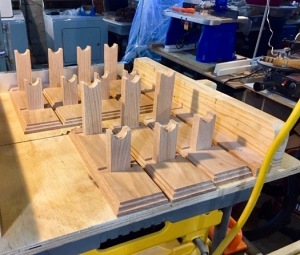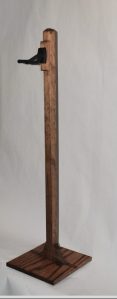You are currently browsing the monthly archive for April 2019.
I’m wrapping up my second year of retirement. I’m almost 24 months removed from the daily commute to a desk in an office and daily face to face interaction with workmates.
Like many retirees, I still have a professional life. I freelance as a content developer which means I do a lot of writing and emailing from my home office.
I have to say I love the arrangement. I like to write, and I like the idea that I can largely plan my own day but still have a sort of regular gig.
Further, I can’t believe how important to me it is to keep up, to be a part of something larger and to know what’s going on in my neck of the professional woods. I think the word I’m looking for is relevance.
Retirement should not mean one loses their relevance.
Before I retired, I made a conscious effort to develop some hobbies and explore some new activities to keep my brain from turning into a bowl of oatmeal. I rather imagined that this would be very important in defining my new self.
I had this vision in my mind that I would somehow quit caring about all the things that mattered within the scope of my fulltime job and suddenly become passionate about horseshoes or bridge or perhaps even golf.
All things considered I stay pretty busy. Actually, just busy enough. And that’s very cool.
Some of these activities include playing the guitar and piano, writing a few songs now and then, singing in my church choir, engaging in some sporting activities and of late, woodworking.
While I never took a shop class in high school, I always had this desire to be proficient in those arts. So, it’s my new hobby and I love it.
So, what wood be the problem?
I started out with the idea of building wooden ship models. I ordered a kit, supposedly designed for beginners. It had a beautiful picture of this schooner on the cover of the box.
When my kit arrived in the mail, I was so excited. I headed downstairs and tore open the box. Inside I found a little bag of shiny metal stuff, three lengths of quarter and eighth inch doweling and a block of wood. There was also an instruction booklet.
After about twenty minutes of messing around with the wooden boat kit, I thought why not build something useful?
I gave the matter some thought and in no time at all, I had a short list of possible projects.
Being a guitar player, I knocked together a guitar stand. I have to say, it’s pretty cool. It features a hanging system instead of a floor-based cradle. The guitar hangs by the headstock.
Next, I looked beyond my music hobby to another hobby I enjoy, that being collecting period firearms from the “golden west” era. Cowboy guns. I fashioned a pistol display stand to show off my matched set of 1876 Colt Single Action Army pistols.
Long story short, when I got done messing around in the basement, I had a couple of extra copies of the guitar stand and a couple of extra pistol stands. What to do with these? I pondered the question and quickly had a solution.
I put them up on E-bay for sale. They both sold within a few days.
Wow, I thought, I’ll make some more and see if I can sell those too. I did and they did.
That was several months ago. Since that time, I’ve upgraded my workshop equipment and opened a storefront on Etsy as well as continuing with E-bay.
I am now manufacturing a variety of woodcraft products in my basement.
When is a hobby not a hobby?
At first, I simply kept a basic design in my head to guide me in building my two main products. I noticed two things as this process evolved. No two products matched and second, the quality was quite variable.
Common sense told me that consistency and quality were two worthy goals.
So, I started thinking about how I was making each of these products. What did I do first, second, third and so forth? I figured out where the inconsistencies between products were, and I realized that consistency would require quality materials, good design and a repeatable process.
Some of the steps in the fabrication process were more complicated than others, some were quick, and others took more time. Working with batches allowed me to fast track the easy stuff and eliminate wasted motion and time on the more intricate steps.
And then there was the fluctuating demand. Some products would go for a couple of weeks without a sale and others would sell at a more consistent rate. Then, suddenly some guy would want to buy several copies at once.
How in the world was I supposed to know how many to make in order to fill my orders and at the sametime not be up to my ears in guitar stands?
This caused me to ask even more questions.
How much lumber should I keep in my shop? How many units should I have finished and ready to ship? Can I use some parts in multiple products?
What about pricing? Am I leaving money on the table? Am I losing sales to lower priced competitors?
The other day a fellow asked me to bid on modifying my pistol display stand for something altogether different. Did I want to stop everything and try to fill an order for a one off?
All of these issues seemed eerily familiar to me. Equally strange was the fact that I had some notion of how to deal with them. How was this possible?
Then the truth hit me between the eyes. After years of talking about and writing about ERP, MRP, lean manufacturing and other related business issues, I found myself sitting in the middle of a manufacturing business.
In a period of 12 weeks I moved from enjoying a nice hobby to thinking about inventory management, demand planning, mitigating constraint points, and dealing with waste. I’m now consumed with process improvement and quality assurance.
My neatly organized office is now part warehouse and distribution center. There is a nice supply of priority mail shipping boxes, packaging tape and a large roll of bubble wrap that I have to walk around to get to my coffee pot.
My marketing experience has also become useful. I’ve done product shoots and written copy for my online stores.
All I can say is I am grateful for everything I learned during my professional career. Because of that, I have some inkling of what to do.
I’m documenting production processes, spec’ing parts and creating product drawings. I’m tracking costs, comparing production statistics between batches to reveal throughput and quality improvement metrics and even doing R&D into product improvements and new products.
Now the question is, do I look at this as a hobby or a new job?
The answer is simple for me. It’s going to remain a hobby. As long as I enjoy it, it will be a hobby.
Building Things is Hard
If manufacturing products was an easy process, there would be more successful companies turning out useful products.
Spending some time in the basement, designing, planning, building and selling my own products has provided me with an excellent view of theory turned into action and concepts turned into reality.
My first guitar stand had a bill of materials consisting of twenty-four parts. Most of those parts are contained within four assemblies which I purchased from a supplier. Two pieces of lumber are worked to fashion the two main components of the product.
The second model has far fewer parts and does not employ third party parts aside from the actual hanger assembly which still comes from the outside. A more sophisticated design allows me to eliminate nearly half the parts and the resulting stand is stronger and more attractive than the first model.
My supply chain consists of Home Depot and Amazon. I constantly monitor the on-line prices for the supply items I regularly order. I also keep an eye out on prices for competing guitar stands.
At the scale or volume, I operate in it is relatively easy to fix and tweak and squeeze out a profit.
But, when I think about designing, building and producing a truly complex product, using many different supply sources, modifying and building out variable configurations and meeting deadlines and profit goals, my mind boggles.
I have developed a whole new level of respect for my manufacturing friends and I have a much greater appreciation for what they do every day of the week. Large complex manufacturing operations require software driven systems to choreograph the complicated dance that brings vast numbers of parts, processes and operations together to turn out the highly complex products that our era demands. But software can only do so much.
Manufacturing is more than ever dependent on people. Creative, ingenious people.


